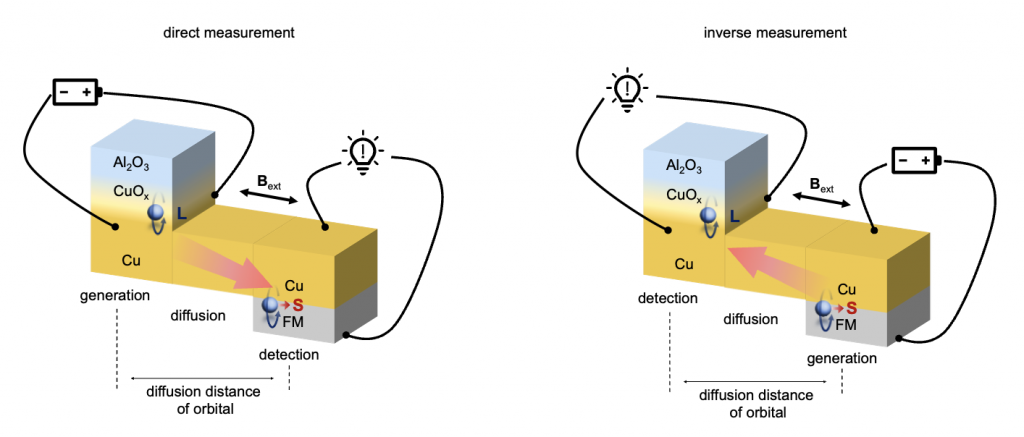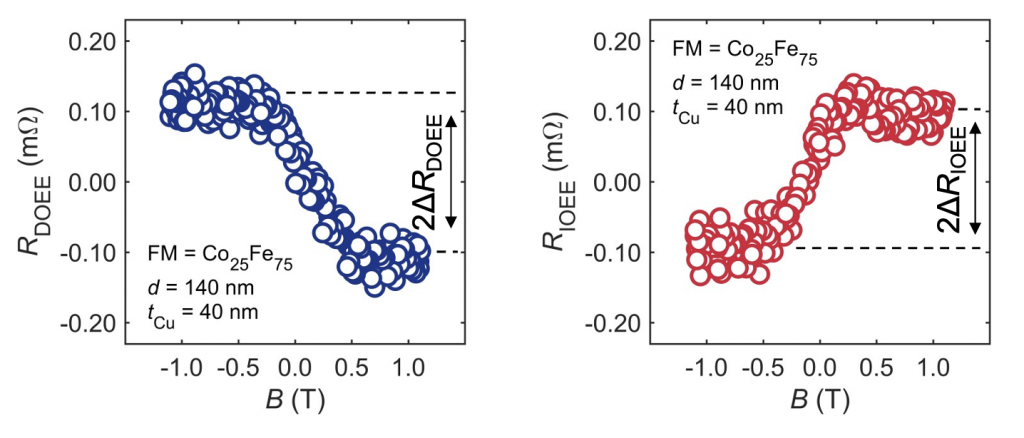電流と軌道の間で相互変換を実験的に確認
東京大学物性研究所のWeiguang Gao大学院生、Liyang Liao特任研究員、一色弘成助教(当時)、大谷義近教授らの研究グループは、同研究所の三輪真嗣准教授、産業技術総合研究所の金俊延主任研究員、ドイツ・ユーリッヒリサーチセンター ピーター・グリュンベルグ研究所のYuriy Mokrousov教授、同研究所Dongwook Go研究員、韓国・浦項工科大学Hyun-Woo Lee教授および韓国科学技術院Kyung-Jin Lee教授らとの国際共同研究により、電流によって軌道磁気モーメントの蓄積(軌道蓄積)を生じさせる「軌道エデルシュタイン効果」と、その逆過程である軌道蓄積から電流を生成する「逆軌道エデルシュタイン効果」の両方を、同一デバイス上で測定・解析することに成功しました。
この成果により、両効果がオンサーガーの相反関係にあることを実験的に検証することに初めて成功しました。
電子はスピンと軌道という二つの自由度を持ちます。これまでスピン自由度は、スピンホール効果やスピントルクなど新たな機能性をエレクトロニクスに付加するものとして活用され、スピントロニクスという分野が発展してきました。
一方、近年注目されている軌道自由度を利用する「オービトロニクス」は、スピン機能が発現しない軽元素でもスピンと同様の現象が生じるほか、エネルギー損失が少ないという特徴があり、次世代の省電力・高速エレクトロニクスとして期待されています。軌道で信号を伝えるには、電流と軌道の間で相互変換が可能であることが重要ですが、これまでその実験的観測はなされていませんでした。
本研究では、CuOx/Cu界面に電流を流すことで軌道蓄積を誘起し、さらにその逆過程である軌道蓄積から電流が生成される現象を実験的に確認しました。加えて、軌道角運動量の減衰長(室温で約100 nm)がCu膜の厚さには依存せず、温度の低下とともに短くなることも明らかにしました。
これらの知見は、軌道角運動量に基づく新しい電子デバイスの開発に向けた基礎を築くものであり、オービトロニクスデバイス設計に新たなパラダイムをもたらすと期待されます。この成果は、2025年7月10日付で『Nature Communications』に掲載されました。
Research Background
Electrons carry two distinct angular momenta: the spin angular momentum S and orbital angular momentum L which can be used for information processing. Recently, researchers found that L surpass S because it less relies on heavy metal (wider and more environmentally friendly materials selection) and have higher torque efficiency (promise a higher information processing speed). A key mechanism in this field is the orbital Edelstein effect (OEE), which means if an electric current is applied to the orbital Edelstein system (such as CuOx/Cu interface), the nonequilibrium L can be induced. However, experimental verification of its Onsager reciprocity, which suggests that charge current can convert to orbital current and vice versa, has been lacking.
This study experimentally demonstrates Onsager’s reciprocity of orbital transport in an orbital Edelstein system by utilizing nonlocal electrical measurements (Fig.1). This method spatially separates the orbital generation and signal detection sites and enables the precise identification of the nonlocal generated by orbital accumulation. Additionally, this study finds that the orbital decay length, approximately 100 nm at room temperature, is independent of the Cu thickness and decreases with decreasing temperature, revealing a distinct contrast to the spin transport behavior. This work provides valuable insights into both the reciprocity of the charge-orbital interconversion and the nonlocal correlation of orbital degree of freedom, laying the ground for orbitronics devices with long-range interconnections.

Research Content
In direct measurement (left panel in Fig.1), an electric current is applied to the CuOx/Cu nanowire where the nonequilibrium L is induced. The nonequilibrium L then diffuses to ferromagnetic (FM) nanowire and generates a voltage signal. Conversely, in inverse measurement (right panel in Fig.1), an electric current is applied to the FM nanowire where the nonequilibrium L is induced. The nonequilibrium L then diffuses to CuOx/Cu nanowire and generates a voltage signal.
The research team find that in the sample with diffusion distance of orbital larger than 100 nm, the clear nonlocal orbital response occurs (Fig.2 left and right panel). Moreover, the overall change of the responses follows the relation: 2ΔRDOEE = −2ΔRIOEE. Those results suggest that orbital Edelstein effect obeys the Onsager’s reciprocal relation.

To further understand the orbital transport, researchers further perform the Cu thickness dependence and temperature dependence, which reveals that the orbital decay length, approximately 100 nm at room temperature, is independent of the Cu thickness and decreases with decreasing temperature, revealing a distinct contrast to the spin transport behavior.
Outlook
This work experimentally verifies the Onsager reciprocal relation for orbital-charge interconversion, establishing a key symmetry in orbital transport. It also reveals several physical properties of orbital accumulation that are distinct from spin, such as their FM dependence, decay behavior and temperature dependence. These findings provide a foundation for further developments in orbital-based electronics and pave the way for inter-connectable orbitronics devices capable of operating over long distances.
発表論文
- Journal:Nature Communications
- Title:Nonlocal electrical detection of reciprocal orbital Edelstein effect
- Authors:Weiguang Gao, Liyang Liao, Hironari Isshiki, Nico Budai, Junyeon Kim, Hyun-Woo Lee, Kyung-Jin Lee, Dongwook Go, Yuriy Mokrousov, Shinji Miwa & Yoshichika Otani* (Corresponding author)
- DOI:10.1038/s41467-025-61602-7
